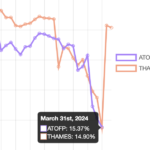Something big is happening with money market funds. 18 months ago, we wrote about how the seven largest US funds were positioning themselves for an upwards shock in Federal Funds rates, with the help of the Fed’s reverse repurchase facility.
The move paid off for them, with their assets growing by 50% to a total of $1.4 trillion, at the expense of bank deposits, according to the updated Risky Finance asset management tool. Now, the MMFs are abandoning the Fed RRP in favour of funding US government-backed home lending. Should we worry?
|
This visualisation combines holdings data from the following: Blackrock FedFund, Blackrock T-Fund, Fidelity Government Cash Reserves, JPMorgan Prime Money Market Fund, JPMorgan U.S. Government Money Market Fund, JPMorgan U.S. Treasury Plus Money Market Fund, Vanguard Federal Money Market Fund. Click on the buttons below the chart to change the metric. Data source: Fund websites |
The seven large funds in our database have grown much faster than the total $5 trillion MMF universe, and in a sense they are bellwethers, not just for MMFs but also for the concept of cash in an inflationary era. Banks’ traditional status as storehouses of cash is in decline. March 2022, the initial date we surveyed the seven MMFs, happened to be the high-water mark for bank deposits, which that month reached $18 trillion according to the Fed.
The seven large funds are controlled by just four parent companies – Fidelity Investments, JP Morgan, Blackrock and Vanguard.
 Levelling the Playing Field
Levelling the Playing Field
 Barclays and Labour's growth plan
Barclays and Labour's growth plan
 Plummeting bonds reflect souring UK mood for outsourcing and privatisation
Plummeting bonds reflect souring UK mood for outsourcing and privatisation
 Dimon rolls trading dice with excess capital
Dimon rolls trading dice with excess capital